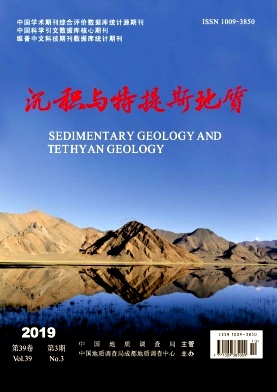|
[1]
|
伊海生,彭军,夏文杰. 扬子东南大陆边缘晚前寒武纪古海洋演化的稀土元素记录[J]. 沉积学报,1995,13(4):13-137.
Google Scholar
|
|
[2]
|
唐世荣,王东安,李任伟. 湘川地区震旦-寒武系硅岩的有机岩石学研究[J]. 沉积学报,1997,15(1):54-59.
Google Scholar
|
|
[3]
|
陈孝红,汪啸风,毛晓冬. 湘西地区晚震旦世黑色岩系地层层序、沉积环境与成因[J]. 地球学报,1999,20(1):87-95.
Google Scholar
|
|
[4]
|
彭军,伊海生,夏文杰. 湘黔桂地区晚前寒武纪层状硅质岩地球化学特征及成因[J]. 地质地球化学,1999,27(4):33-39.
Google Scholar
|
|
[5]
|
彭军,夏文杰,伊海生. 湘西晚前寒武纪层状硅质岩的热水沉积地球化学标志及其环境意义[J]. 岩相古地理,1999,19:29-37
Google Scholar
|
|
[6]
|
赵国连. 生物作用在二氧化硅聚集沉淀过程中的意义-以皖南浙西的硅质岩为例[J]. 沉积学报,1999,17(1):30-37.
Google Scholar
|
|
[7]
|
彭军,徐望国. 湘西上震旦统层状硅质岩沉积环境的地球化学标志[J]. 地球化学,2001,30:293-298.
Google Scholar
|
|
[8]
|
胡杰. 桂东北较深水相前寒武纪之交的硅质微生物岩[J]. 微体古生物学报,2008,25(3):291-305.
Google Scholar
|
|
[9]
|
常华进,储雪蕾,冯连君,等. 湖南安化留茶坡硅质岩的REE地球化学特征及其意义[J]. 中国地质,2008,35:879-887.
Google Scholar
|
|
[10]
|
常华进,储雪蕾,冯连君,等. 华南老堡组硅质岩中草莓状黄铁矿-埃迪卡拉纪末期深海缺氧的证据[J]. 岩石学报, 2009,25:1001-1007.
Google Scholar
|
|
[11]
|
杨兴莲,朱茂炎,赵元龙,等. 黔东震旦系-下寒武统黑色岩系稀土元素地球化学特征[J]. 地质论评,2008,54(1):3-15.
Google Scholar
|
|
[12]
|
张位华,姜立君,高慧,杨瑞东. 贵州寒武系底部黑色硅质岩成因及沉积环境探讨[J]. 矿物岩石地球化学通报,2003,22(2):174-178.
Google Scholar
|
|
[13]
|
常华进,储雪蕾,冯连君,等. 桂北泗里口老堡组硅质岩的常量、稀土元素特征及成因指示[J]. 沉积学报,2010,28(6):1098-1107.
Google Scholar
|
|
[14]
|
贵州省地质调查院. 贵州省区域地质志[M]. 北京:地质出版社,2013.
Google Scholar
|
|
[15]
|
周正茂, 李核良, 赵志强, 等. 贵州1:5万谯家铺幅(H49E023002)、甘龙口幅(H49E023003)、合水幅(H49E024003) 3幅区域地质调查报告[R]. 重庆:重庆市地质矿产勘查开发局607地质队,2018.
Google Scholar
|
|
[16]
|
Yamamoto K. Geochemical characteristics and depositional environments of cherts and ssociated rocks in the Franciscan and Shimanto terranes[J]. Sedimentary Geology,1987,52:65~108.
Google Scholar
|
|
[17]
|
朱炳光. 硅质岩成因研究进展[J]. 中国西部科技,2011,10(26):10-11,36.
Google Scholar
|
|
[18]
|
Murray R W. Chemical criteria to identify the depositional environment ofchert:General principles and applications[J]. Sedimentary Geology,1994,90(3/4):213-232.
Google Scholar
|
|
[19]
|
Girt G H, Ridge D L, Knaack C, et al. Provenance and depositional setting of Paleozoic chert and argillite, Sierra Nevada,California[J]. Journal of Sedimentary Research,1996, 66(1):107-118.
Google Scholar
|
|
[20]
|
张聪,黄虎,侯明才. 地球化学方法在硅质岩成因与构造背景研究中的进展及问题[J]. 成都理工大学学报(自然科学版),2017,44(3):293-304.
Google Scholar
|
|
[21]
|
Jones B, Manning D A C. Comparison of geochemical indices used for the interpretation of palaeoredox conditions in ancient mudstones[J]. Chemical Geology, 1994, 111(1-4):111-129.
Google Scholar
|
|
[22]
|
赵志强,凌云,李核良,等. 重庆秀山小茶园大塘坡组含锰岩系地球化学特征分析及意义[J]. 矿物岩石地球化学通报, 2019,38(2):330-341.
Google Scholar
|
|
[23]
|
谢桂青,胡瑞忠,方维萱,漆亮. 云南墨江金矿床硅质岩沉积环境的地球化学探讨[J]. 地球化学, 2001, 30(5):491-496.
Google Scholar
|
|
[24]
|
Crowley T J, Berner R A. Palaeoclimate:CO2 and climate change[J]. Science,2001,292(5518):870-872.
Google Scholar
|
|
[25]
|
毛晓东,汪啸风,陈孝红. 扬子地台东南缘震旦纪-早寒武世沉积环境及有关矿产[J]. 华南地质与矿产,1998,2:24-31.
Google Scholar
|






 DownLoad:
DownLoad: